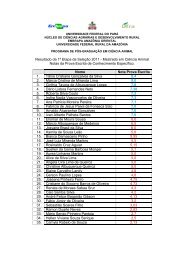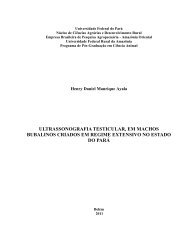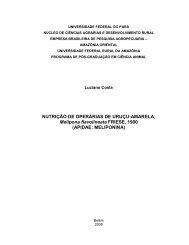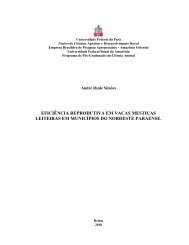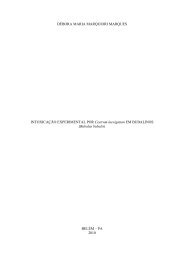diversidade e densidade ictiofaunística em lagos de várzea da ...
diversidade e densidade ictiofaunística em lagos de várzea da ...
diversidade e densidade ictiofaunística em lagos de várzea da ...
You also want an ePaper? Increase the reach of your titles
YUMPU automatically turns print PDFs into web optimized ePapers that Google loves.
ABSTRACT<br />
The structure of the fish community in amazonian <strong>várzea</strong> lakes is <strong>de</strong>termined by the flood pulse<br />
and seasonal and <strong>da</strong>ily variations in the physico-ch<strong>em</strong>ical parameters of the water.<br />
The objective of this work was to characterize the fish community structure of four lakes in<br />
different stages of the seasonal cycle. Fish samples were taken bimonthly along one year in four<br />
lakes at Mamirauá Sustainable Development Reserve, state of Amazonas, Brazil. The richness of<br />
species and the fish biomass were analyzed, in or<strong>de</strong>r to investigate how much the community<br />
patterns were regulated by the environmental variables. A total of 6,058 individual fish were<br />
collected, representing 6 or<strong>de</strong>rs, 21 families, 76 genera and 116 species. The or<strong>de</strong>rs<br />
Characiformes and Siluriformes presented the largest variety of families and species, reaching<br />
together around 90% of the captured specimens. The fish fauna varied between different periods<br />
and lakes, and the highest richness and biomass values were found in the water level dropping<br />
season, except in Taracoá Lake with greater richness in the flooding season. The species<br />
Potamorhina latior, Potamorhina altamazonica, Mylossoma duriventre, Amblydoras hancokii,<br />
Amblydoras sp., Liposarcus par<strong>da</strong>lis, Psectrogaster amazonica and Osteoglossum bicirrhosum<br />
showed the highest number of individuals. Oxydoras niger, Colossoma macropomum, Cichla<br />
monoculus, Osteoglossum bicirrhosum, Arapaima gigas and Pseudoplatystoma tigrinum were the<br />
dominant species in biomass. The analysis of the physico-ch<strong>em</strong>ical parameters indicates that the<br />
changes along the year and the flood pulse influence <strong>de</strong>termine the fish community structure, and<br />
the set of parameters composed by dissolved oxygen, pH and water t<strong>em</strong>perature se<strong>em</strong>ingly<br />
explains the fish community pattern. Similarity Analysis indicates that the fish fauna composition<br />
in the same time of the flood pulse in consecutive years are much alike. Therefore, it is probable<br />
that the fish community composition is re-established every cycle, with the connection of the<br />
different water bodies during the flood<br />
7vii



